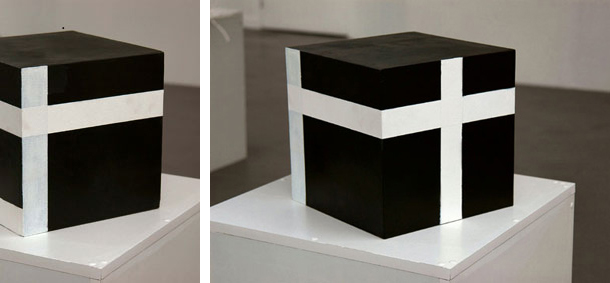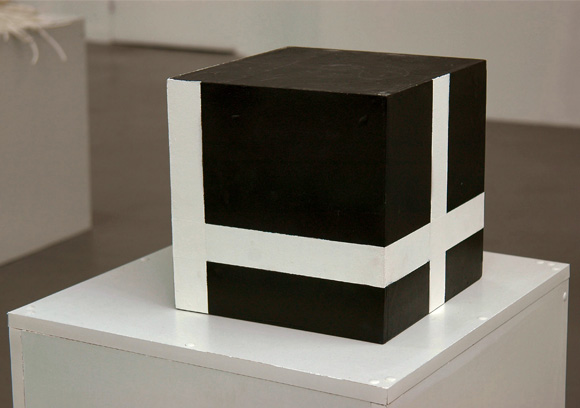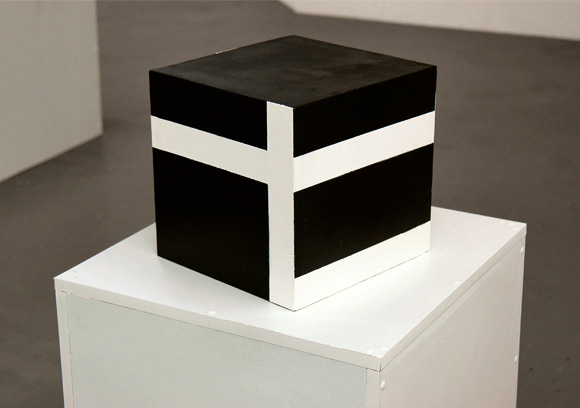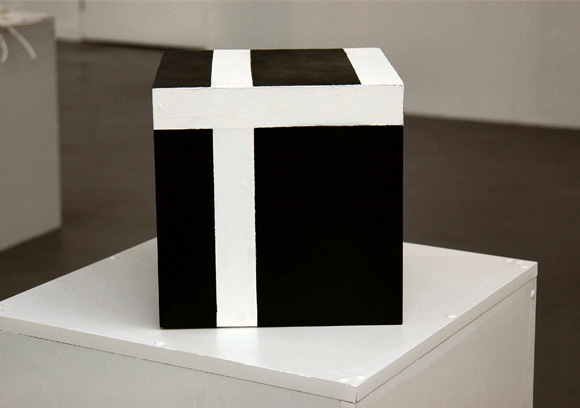| |
|
|
11.
| New proposals |
| |


2004, painted wooden cube.
Exhibition view from Comprendra bien qui comprendra le dernier, CAC Le Parvis, 2004, Ibos.
Courtesy of the artist and Ceysson & Benetiere, Paris.
Ed. of 5 + 1 A.P.
'' The artwork is like a conscientious objector that suppresses the boundaries between seeing and touching, between viewer and artist, sacred and profane. ''
Studio Fatmi, September 2004

New proposals
Exhibition view from Comprendra bien qui comprendra le dernier, CAC Le Parvis, 2004, Ibos.
Courtesy of the artist.

New proposals
Exhibition view from Comprendra bien qui comprendra le dernier, CAC Le Parvis, 2004, Ibos.
Courtesy of the artist.

New proposals
Exhibition view from Comprendra bien qui comprendra le dernier, CAC Le Parvis, 2004, Ibos.
Courtesy of the artist.
|
|
|
|
|
|
Nouvelles propositions est une sculpture qui mise expressément sur l’expérience sensitive du regardeur dans un rapport d’appropriation direct de l’objet. Posé sur un socle, un cube noir à bandes blanches est construit sur une esthétique minimaliste qui puise sa force dans une économie des matériaux.
La réduction des lois de l’optique et de la géométrie aux principes de la sculpture font de cette œuvre la métaphore d’une installation architecturale. Ainsi, l’ascétisme des lignes participe d’une transsubstantiation de l’objet-cube devenu figure symbolique de « La Mecque ». Également appelée « La Cité Bénie » parce que dans les profondeurs du bassin de la ville se dresse l’ancien temple cyclopéen qui, selon le Coran, a été bâti par Abraham en l’honneur de l’Eternel. La Mecque est cette double architecture de l’invisible, consacré au divin et dont la représentation est interdite. Transfiguré, le lieu saint de l’islam progresse alors dans une force éruptive pour se laisser apprivoiser par ses nouvelles configurations. Tout se tient et rien ne se maintient.
L’œuvre est cet objecteur de conscience qui affranchit toutes les limites symboliques entre le voir et le toucher, le regardeur et l’artiste, le sacré et le profane. Dans un goût patent pour le déchiffrement, l’œuvre alimente ce rapport actif voire convulsif, qui donne à lire les possibles oppositions des modalités de son existence.
Studio Fatmi, Septembre 2004. |
|
New Proposals is a sculpture that focuses on the viewer’s sensitive experience in a context where the object is available for direct appropriation. Resting on a pedestal, a black cube with white stripes is constructed following a minimalist esthetic that draws its strength from the small amount of materials employed.
Reducing the laws of optics and geometry to the principles of sculpture makes this artwork a metaphor for an architectural installation. In this way, the sobriety of its lines pertains to a transubstantiation of the cube-object that becomes a symbolic representation of “Mecca”, also called “The Blessed City” because deep in the city’s heart can be found the ancient temple that, according to the Koran, was built by Abraham to honor the Eternal.
Mecca has this double architecture of the invisible, dedicated to the divine, and whose representation is forbidden. Transfigured, the holy place of Islam evolves into an eruptive force and eventually lets itself be tamed by its new configurations. Everything is connected and nothing is forever.
The artwork is like a conscientious objector that suppresses the boundaries between seeing and touching, between viewer and artist, sacred and profane. With an obvious penchant for deciphering, it nourishes this active, even convulsive relationship, showing the possible oppositions of the modalities of its existence.
Studio Fatmi, September 2004. |
|
|
|